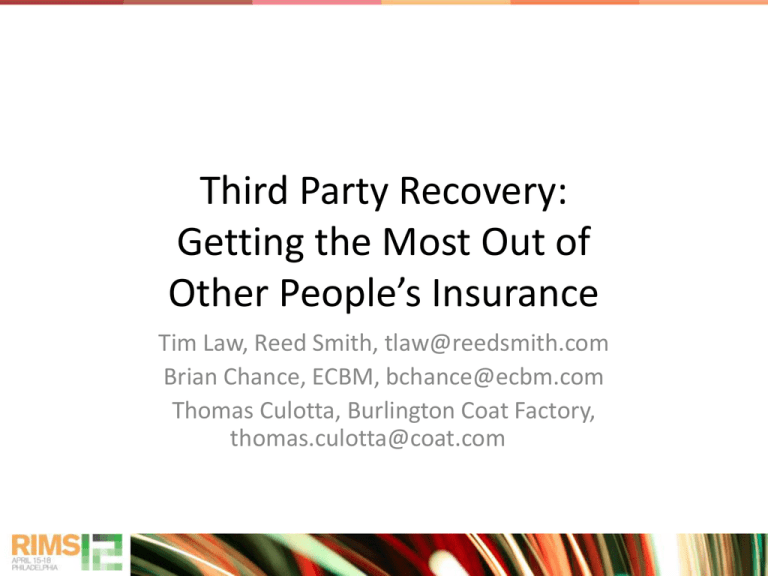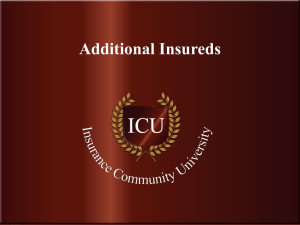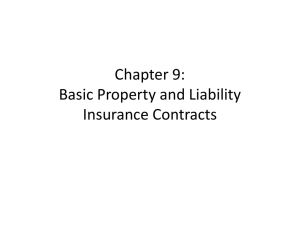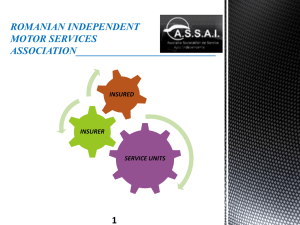Third Party Recovery Getting the Most Out of Other People`s Insurance
advertisement

Third Party Recovery: Getting the Most Out of Other People’s Insurance Tim Law, Reed Smith, tlaw@reedsmith.com Brian Chance, ECBM, bchance@ecbm.com Thomas Culotta, Burlington Coat Factory, thomas.culotta@coat.com Introduction to Speakers • Speakers • Brian Chance, ECBM – Broker Perspective • Tom Culotta, Burlington Coat Factory – Risk Management and Business Perspective • Tim Law, Reed Smith – Legal Perspective Introduction to Topic • Third Party Recoveries – Recovering from parties other than your own insurance company – Additional Insured Status – Contractual and Common Law Indemnity – Subrogation – Contribution Legal Benefits of Additional Insured • When done right: – Gives Additional Insured Direct Rights Against Insurance Company – Duty to Defend Additional Insured v. Duty to Reimburse Indemnitor for Payment of Defense Costs – Belt and Suspenders With Indemnification – Should Prevent Subrogation Against Additional Insured By Carrier Business Benefits to Additional Insured • Saves Premium • Protects Claim Experience • Good Risk Transfer Show Me the Endorsement • Becoming an Additional Insured – Blanket Additional Insured Provisions • Definition of Insured • Broad endorsements • Typical Requirements – Written Contract – Prior to Occurrence – Requires Naming of Particular Company as Additional Insured – Specific Endorsements Additional Insured: Common Problems • Failure to List All Organizations and People Who Should Be Additional Insureds • Conflicts Between Insureds and Need for Independent Counsel • Extent of Additional Insured Protection – Certain States limit the scope of coverage • Other Insurance Provisions – Your Insurance Still Applies – Primary and Non-Contributory? – Conflicting other insurance clauses; courts determine allocation; may be pro rata. ISO Additional Insured Endorsements • 32 Different ISO Additional Insured Endorsements – Not going to address all 32, but . . . • Each has different language and purpose ISO Endorsements • Additional Insured – Owners, Lessees or Contractors – Scheduled Person or Organization – CG 20 10 11-85 – Covers Sole Fault of the Additional Insured – Includes Completed Operations ISO Endorsements • Additional Insured – Owners, Lessees or Contractors – Scheduled Person or Organization – CG 20 10 03 97 – Covers Sole Fault – No completed operations coverage? ISO Endorsements • Additional Insured – Owners, Lessees or Contractors – Scheduled Person or Organization – CG 20 10 10 01 – Similar to previous endorsement, but completely eliminates coverage for completed operations ISO Endorsements • Additional Insured – Owners, Lessees or Contractors – Scheduled Person or Organization – CG 20 10 07 04 – Designation of locations of covered operations – Changes • “with respect to liability arising out of your ongoing operations performed for that insured” to • “your acts or omissions or the acts or omissions of those acting on your behalf in the performance of your ongoing operations for the additional insured(s) at the location(s) designated above.” ISO Endorsements • Additional Insured – Owners, Lessees or Contractors – Automatic Status when Required in a Construction Agreement with You – CG 20 33 07 04 – Blanket endorsement – Does not include completed operations Vendors Endorsements • Covers purchaser or distributor for liability arising from its sale of the manufacturer’s products in the ordinary course of business • Exclusions – coverage extends only to matters in which the vendor has not contributed independently to injury or damage • Coverage can be direct, making vendor an insured, or can require payment of vendor’s liability at request of insured. • Additional insured coverage can be better than vendor’s liability coverage for vendor. OCIPS & CCIPS • • • • Owner-controlled insurance programs Contractor-controlled insurance programs All participants are named insureds Avoids subrogation and additional insured issues • Administratively complex; only for big projects • Can reduce overall limits available to pay major loss. Certificates of Insurance • Not a contract • Not insurance • Does not automatically make you an Additional Insured – but it could! • Does not provide a right to payment or notice • Proof of Someone Else’s Insurance – At a particular time – Without coverage details Benefits of Certificates of Insurance • Provides proof that contractual requirements to have certain amounts of insurance are met • Provides proof that subcontractors have worker’s compensation insurance, so no premium is charged to general contractor for employees of subcontractor • May get right to notice of cancellation, but not expiration. Prior “notice” language in ACORD form required the insurer to “endeavor” to notify of cancellation. Now, requirement only to deliver notice of cancellation “in accordance with policy provisions.” Insurance Requirement • Amount of Limits – – – – • Size of subcontractor Per occurrence v. aggregate Per location Claims made coverage Type – General Liability – Umbrella – Worker’s compensation • Terms – Primary and Non-contributory • Duration – Require insurance to be in place for duration of work, and beyond if completed operations coverage is desired. – Require prompt notice of cancellation, replacement, changes in terms, renewal, and non-renewal • Rating – “A-rated” by A.M. Best? Indemnity Agreement • Requirement to indemnify for certain loss – – – – – – – – – – “Arising out of” subcontractor’s work “Resulting from” subcontractor’s negligence Reciprocal indemnity? Applies only in the event of sole negligence? Contractor’s independent negligence? Bodily injury, property damage, anything else? “Hold Harmless” Duty to Defend or Conditional Duty to Pay Defense Costs Attorney fees for enforcing indemnity Dollar limits on indemnification obligation? Contract price? Indemnification obligation to survive contract expiration, but any time limit? – Does indemnity apply in addition to insurance or after insurance? Contractual Liability Coverage • Contractual liability coverage should parallel scope of any indemnity agreement • Typically, applies only to tort liability assumed in indemnity agreement • Should also apply to your contractual liability for someone else’s contractual liability for yet another party’s tort liability • Indemnity agreements are “Insured Contracts” so excepted from exclusion for liability assumed in contract. • Does not provide indemnitee with “insured” status. Name as Additional Insured • Additional Insured Requirement – Different than Indemnification requirement – Must be in written contract prior to occurrence – Must include all persons and entities that should be insured – Consider requiring completed operations coverage – Policy may need to be specifically endorsed or “blanket” coverage may be provided. – State in contract that additional insured coverage is intended to be primary and non-contributory. This should also be addressed in insurance policy, if possible. Documentation Requirement • Contract can require party to provide certain insurance documentation. – Insurance Policies – Certificate of Insurance – Communications with Insurance Companies re Claim • Any documentation requirement should survive expiration or termination of contract • Be careful of expiration of policy term. Contract can require documentation to be provided on renewal. For completed operations losses, subsequent policies may be required to provide coverage. Absent Contract • State law addresses multiple parties being liable for single loss. – Joint and several liability • If you are the least bit at fault, you can be required to pay everything • Some states limit to those 25% or 50% liable • Some states limit to certain categories of damages (medical, “objectively verifiable monetary losses”) – Several liability Contribution Law • If tortfeasor pays more than allocated share, may seek excess from a joint tortfeasor • Each tortfeasor is responsible for its own attorneys fees • Practical: shifts risk of non-collectibility to those tortfeasors who can pay Indemnity Law • After enactment of contribution and comparative fault statutes, common law indemnity limited to shifting entire loss from innocent indemnitee to negligent indemnitor • California – partial comparative indemnity • Texas – seller or distributor can seek indemnity from manufacturer Subrogation • Insurance company’s right of recovery in subrogation from a third-party is wholly derivative of the policyholder’s right of recovery • If the negligence of a third party contributed to the policyholder’s loss, then that third party may be liable to the policyholder. If the policyholder is insured for the loss, the policyholder has a right to prompt recovery from its insurance company, which is then permitted to pursue the liable third party. Anti-Subrogation Rule • Subrogation is an equitable doctrine • The “anti-subrogation rule” forbids an insurance company from seeking subrogation from its own insured. • If an insurance company pays a loss to one insured company, it is forbidden from seeking recovery from that same company or an insured sister company. Made Whole Doctrine • “Make Whole” or “Made Whole” doctrine, a/k/a the “Complete Compensation” rule • Allows an insurance company to enforce its subrogation rights only after the insured has been fully compensated for all of its loss. • When deciding priority of recovery, should it be the insurance company who provided some measure of insurance against loss in exchange for a premium or should it be the policyholder who purchased some measure of insurance against the loss? • Any inability to recover fully from third parties should rest on the seller of insurance, not on the insurance consumer. “Made Whole” Problems • Situations in which an insurance company’s payment will not make the policyholder whole – Certain loss is not covered by the insurance policy • Policyholder should receive payment of uncovered loss before insurance company receives payment of covered loss – Loss is in excess of the policy limits • Policyholder should receive payment of loss in excess of limits before insurance company receives payment of loss within limits – Loss may fall within a deductible or retention • Policyholder should receive payment of loss within deductible or retention before insurance company receives payment of loss in excess of deductible or retention • Recoveries should not be taken “off the top” of damages Made Whole: Deductible Example • • • • • If a $100,000 policy contains a $10,000 deductible, the insurance company would be obligated to pay $100,000 of a $110,000 insured loss. Similarly, the insurance company would be required to pay $1,000 of an $11,000 insured loss. In the first example, the policyholder has a $110,000 claim against any third party tortfeasors, and in the latter example, an $11,000 claim. Policyholder’s contractual right to recover $100,000 or $1,000 from the insurance company is not impacted by the third party’s liability to the policyholder for causing the loss. Policyholder’s right to recover $110,000 or $11,000 in tort from the third party is not impacted by the insurance company’s actual or potential contractual liability under the insurance policy. The insurance company “steps into the shoes” of the policyholder to recover from third parties to the extent of its payment, but the policyholder’s right of recovery remains primary, while the right of subrogation remains derivative and secondary, applicable only when the policyholder is made whole. Working Effectively with Lawyers • Law firm selection – How to choose – What to consider • Alternative Fee Agreements – Using contingent fees – Fixed Fee retentions • Use of subrogation vendors Prepare for Recovery • Investigate cause of loss and damages • Assemble relevant documents • Identify possible tortfeasors and place potentially responsible parties on notice • Make indemnity demands promptly and follow up • Evaluate collectability and timing – better to get 1 in hand, than pursue 2 in bush • Cooperate with insurance company and press for active recovery effort. Workers Compensation Recoveries • Many worker’s compensation policies have retrospective premiums or large deductibles. • Important to press carrier to evaluate and pursue third party recoveries. • May be requirements for prompt notice of subrogation liens. • Monitor litigation by employee against tortfeasor Maintaining Customer and Vendor Relationships • Satisfy the Customer First • Don’t lose track of corporate mission • Determine goals of business units in your own company and do not act at cross purposes • Many disputes can be avoided through careful selection of business partners – Consider financial condition of business partners and ability to make whole – Surety bonds and collateral • Leveraging the business relationship – Continue to use vendor – Initiate competition with other vendors – Eliminate vendor Third Party Recovery as Risk Shifting • Risk Management must have role not just in insurance policies but in contracts with business partners to ensure proper indemnity and additional insured protections. • Risk Managers must also partner with inhouse counsel, facilities, construction and other applicable departments—beyond the contracting process—to ensure that additional protections are addressed. Alternative Dispute Resolution • Consider arbitration provisions. Arbitration has positives and negatives: • Positives – Possibly quicker – Possibly shorter – Less public, more confidential • Negatives – You have to pay the arbitrators – Limited due process and appeal rights – Tendency of arbitrators to split the baby Conclusion • There are very significant opportunities to pursue third party recoveries. – Get your contracts in order. – Get your insurance policies in order. – Exercise diligence in pressing indemnity demands, pursuing insurance coverage from others, encouraging recovery efforts by your carrier, and satisfying customer. • Questions









